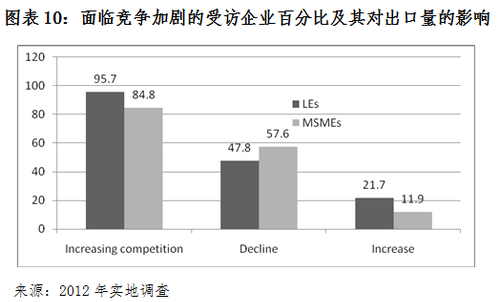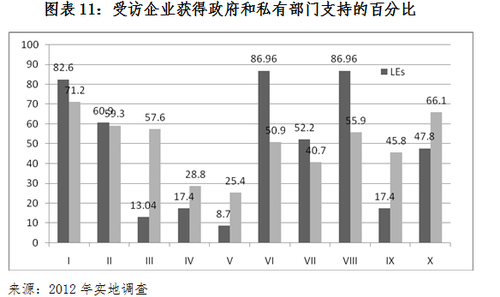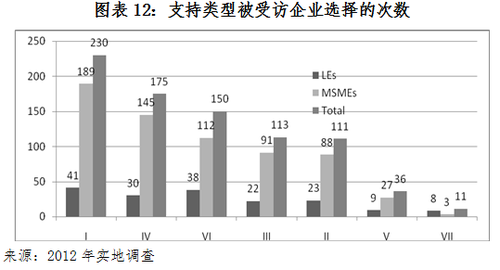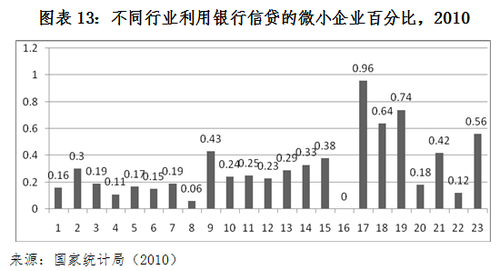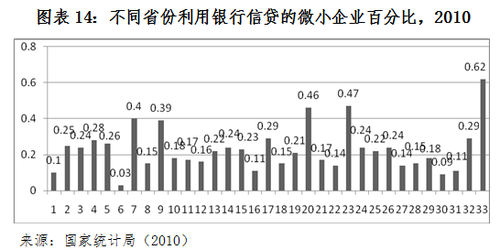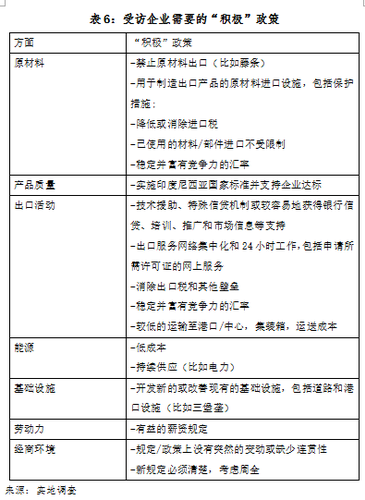2012年中国—东盟社会发展与减贫论坛11
化会直接或间接的影响到所有行业的所有企业,不论大小,不论服务于外部还是内部市场。理论上,贸易自由化可以通过很多方式来影响一家本土企业,其中一种就是通过加剧国外和国内市场的竞争。在国内市场上,降低或消除现有的进口税、配额和其他的非关税壁垒将增加来自外部的竞争,因为会有越来越多的进口商品和服务进入国内市场。这会促使效率低、生产力低或竞争力低的本土企业消除不必要的成本构成,利用外部规模和范围经济,并采用更为创新的技术和更好的管理方法,从而提高效率、生产力和竞争力,这也可能造成企业倒闭。因此,可以从工厂规模的扩大(比如,效率尺度)中看出一国经济对全球贸易的开放程度,特别是因为本土企业采用更有效的技术、管理、组织和生产方法。
而在出口市场上,进口国现有的进口税、配额和其他非关税壁垒的减少吸引了更多国外的供应商。另一方面,由于贸易自由化也意味着消除出口税和配额等出口限制,更多的国家开始出口,因此进口国的国内市场将变得更为拥挤,对出口国来说,这就意味着更加激烈的竞争。
在这一问题上,研究人员要求受访企业给出他们对出口市场竞争状况的看法:在过去几年或十年中,竞争是否变得更为激烈(回答应为“是”或“否”),这又对其出口量造成了哪些影响:下降,不变,或增加。结果显示,在认为竞争更为激烈的两种类型的受访企业中,认为出口量增加的企业比例低于认为出口量下降的企业比例(图表10)。
图表10:面临竞争加剧的受访企业百分比及其对出口量的影响
1.1.1 政府和私有部门的支持
最后一个重要问题是政府机构和私有组织的支持,即贸易部门(I),行业(II),和合作社和中小企业(III);研发机构(IV);大学(V);工商业联合会(Kadin;VI);商业协会(VII);银行和非银行金融机构(VIII);国有企业(BUMN;IX)和当地政府(Pemda;X)。受访企业要回答以下的问题:他们是否得到(过)来自上述机构的支持;如果是,是哪种形式的支持。
从图表11可以看出,受访企业的回答提供了至少三项有趣的发现。第一,百分比上,得到过来自研发机构和大学的支持或援助的微小中企业数量多于大型企业。然而,人们通常认为研发机构和大学更愿意与大型企业合作,而不是微小中企业(尤其是微小企业),主要原因有两点:(i)长远来看,可盈利市场更大(即与大型企业合作需求机会更多),和(ii)大型企业有足够的资金投资于此类合作。第二,印度尼西亚的工商业联合会和商业协会,尤其是区域/当地层面的组织,应在支持微小中企业发展方面发挥关键作用,但调查显示的情况却刚好相反:受访企业中,获得这两个私有组织服务/支持的大型企业更多。第三,受访的大型企业中得到(过)银行或非银行金融机构金融支持的比例高于微小中企业,这可能说明很明显的一点,即尽管政府努力增加金融机构对企业的支持,包括几年前推出的一项不基于合作的特殊信贷制度,即印度尼西亚的人民企业贷款(KUR),许多微小中企业仍然无法获得商业银行等金融机构的支持。
支持的类型上,研究人员提供一份支持类型的清单给受访企业,让他们选择(可以多选),即培训(I),融资(II),技术援助(III),营销/推广(IV),原材料/投入采购(V),市场信息(VI),和其他(VII)。图表12显示,根据每个类型被受访企业选择的次数,培训是最普遍的支持类型,共出现230次,而且培训也是受访的微小中企业(189)眼中最重要的类型,多于受访的大型企业(41)。受访的微小中企业眼中其次重要的是营销/推广支持,再次是营销信息。在“其他”类型中,受访企业选择次数最多的是申请出口许可证方面的帮助。
印度尼西亚银行在支持微小中企业方面发挥的作用。2010年的全国数据(国家统计局)显示,制造行业中,利用外部资金来源的559971家微小企业中,仅有112627家使用银行信贷,约占20%。然而,不同行业(图表13)、不同省份(图表14)百分比也会有所变化。从行业上看,百分比最高的是生产其他化工产品的行业,这表明在这一行业里,几乎全部现有的微小企业都使用了银行信贷,然而在基本化工产品行业,没有一家微小企业使用过银行设施。从省份上看,令人吃惊的是,现有的微小企业中获得银行信贷比例最高的是在巴布亚省。导致省份差异的因素各种各样,包括微小企业和银行的分布零散,企业面临的制约因素,生产的产品(决定了对外部资本的需求),当地政府官员是否发挥了积极作用,向当地的微小企业推广现有的信贷机制,当地银行员工是否积极地接触当地的微小企业。
最后,非金融组织(包括政府)的作用。与实地调查的发现和上述的讨论进行对比,2010年国家统计局的数据还显示,在2732724家微小企业中,仅有83196家企业(或约3%)得到过政府援助或其他类型的支持;30697家企业(1.1%)得到过私有部门(比如大学,工商业联合会,商业协会)的支持;8207家企业(0.3%)得到过非政府组织的支持。当然,在不同的行业和省份,这些组织对微小企业的重要性也有所不同。
1.1.2 政策
一家企业的出口增长同时取决于两组因素,即:管理、公司组织、拥有/使用的技术、雇员技能、公司战略等内部因素,和外部因素,包括:(i)政府政策和(ii)非政策因素,比如社会、政治和经济条件,全国劳动力状况(数量和质量),原材料的可利用情况和其他必要投入等。另一方面,政府政策通过两个途径来影响一家企业的出口增长:直接和间接。直接的政策指专门调节全国所有或某些商品出口量的政策(比如消除出口壁垒,降低/消除用于出口生产的原材料进口税,为出口商颁布一项有补贴利率的特别信贷制度)。另一方面,间接的政策指在其他领域但也会影响出口的政策。比如,保持其他因素不变,采取扩张性的财政政策来促进基础设施建设必然会对出口商产生积极影响。
政府政策(比如规定、法律、决议、或部门/总统指令)方面,受访企业要就以下三个方面做出回答:(i)为企业出口带来积极影响的一些政策;(ii)为企业出口带来消极影响的一些政策;和(iii)企业最需要的用以增加出口的激励措施。在调查期间,许多受访企业,尤其是微小企业难以做出回答,因为许多企业并不知道现有的会直接或间接地影响其出口的官方规定,或者他们不知道何种激励措施或政策对其出口活动有利。因此,许多受访的微小中企业并未给出明确的回答。然而,给出的答案明确显示了他们需要的“积极”的政策,见表6。
2. 结论和政策建议
根据三个地点实地调查的原始资料和次级资料,本研究显示了印度尼西亚出口导向型微小中企业的四个情况。第一,业绩方面,企业的出口实力相对较弱。实地调查甚至显示,许多受访的微小中企业并不直接出口,这是由于印度尼西亚的微小中企业,尤其是微小企业,缺少信息、资金和技能等必需的投入。这就是使企业很难(如果可以)改善自身的生产力及其产品质量,而这两点是影响企业竞争力以及直接出口能力的重要因素。
第二,营销、原材料采购和资金方面。正如之前提到的,很难获得正式的信贷来源往往会导致资金匮乏,从而可能造成营销困难,因为大部分微小中企业,尤其是小型和微型企业没有足够资金去开发市场。
第三,获得贸易便利化措施的情况。研究显示,大型企业的情况好于微小中企业。而情况不良的主要原因是不了解或不知道现有的贸易便利化措施。全国数据也显示了与实地调查相同的发现,即许多印度尼西亚的微小中企业,尤其是微小企业,无法很好的利用现有的设施仅仅因为他们不知道有这样的设施或不了解程序。
第四,贸易部、工业部和合作社和中小企业部等政府部门和印度尼西亚工商业联合会、商业协会和商业银行等私有组织在支持微小中企业中所扮演的角色。研究发现,并不是所有受访的微小中企业都得打过政府(即使是合作社和中小企业部)和上述私有组织的支持。相反,获得私有组织支持的大型企业数量占所有受访大型企业的比例高于微小中企业。得到(过)银行或非银行金融机构支持的受访企业中,大型企业的数量多于微小中企业。
这些发现有政策上的意义。具体来说,本研究提出以下四项建议:
1) 所有设有微小中企业发展项目或为企业提供服务的政府部门和非部门组织,尤其是应在支持微小中企业发展中发挥主导作用的合作社和中小企业部,都应该审视接触潜在微小中企业或支持微小中企业的方法,包括协调不同地区的政府,以便保证所有地区的所有潜在微小中企业都能获得同样的支持。自从区域自治实施以来,部门和当地政府办公室直接的良好协调就变得非常重要。另一方面,区域/当地政府应该主动选择帮助本地微小中企业的最佳方式,因为他们比中央政府更加了解本地的实际情况和本地微小中企业的需求,至少在理论层面上是这样。
2) 根据作者长期的经验,当地微小中企业,甚至是当地政府往往不了解或不知道目前中央政府(比如合作社和中小企业部)发起的项目;或者,即使当地政府知道,他们也不知道如何在本辖区内实施,或者,即使当地微小中企业听说了一项具体的项目,他们也不知道自己是否满足参与的条件。甚至当地工商业联合会或相关的商业协会有时都不知道目前中央政府实施的一项具体项目。因此,现有项目/服务的区域社会化/推广十分重要,要有效且高效地实现这一点可以与当地私有组织合作实施项目/服务,这样的组织包括印度尼西亚工商业联合会(卡丁达),商业协会,大学和非政府组织。
3) 国家收支预算案(地方政府是地方收支预算案)允许政府支持微小中企业的资金有限,包括人民企业贷款在内的企业信贷机会成本很高。因此,获得金融支持的潜在的微小中企业就必须经过筛选,出口潜力大的企业应该优先。这样做的一个结果就是政府必须将人民企业贷款的最高额度提升到5百万卢比以上,因为同只服务于国内市场相比,出口的成本更高。
4) 中央政府目前采取的微小中企业发展方式/战略典范。政府看重微小中企业主要是因为它们能创造就业,在全球化和世界贸易自由化的时代,扶贫已经不再重要。当下,微小中企业更应该被视为国家出口发展和增长的重要源泉(即使不是最重要的),同时也不应忘记微小中企业所扮演的其他重要角色,即包括大型企业在内的国内出口公司有效且竞争力强的本土/国内供应商。这一新典范的意义在于,在获得政府服务方面,出口导向型微小中企业和本土供应商/转包商应该优先于仅为本土市场提供简单消费品的微小中企业。
参考文献
ADB (2002), “Report and Recommendation of the President to the Boards of Directors on a Proposed Loan and Technical Assistance Grant to the Republic of Indonesia for the Small and Medium Enterprise Export Development Project”, ADB RRP: INO 34331, November, Jakarta: Asian Development Bank.
ADB (2009), Key Indicators for Asia and thePacific 2009, Manila: Asian Development Bank.
Alavi, Hamid (2009), “Promoting the Development of SMEs in Times of Crisis: Trade Facilitation and Trade Finance”, paper presented at Regional Policy Forum on Trade Facilitation and SMEs in Times of Crisis, 20-22 May, Beijing, China.
Alburo, Florian A. (2008), “Context of IT in TF”, paper presented at the ARTNeT Research Team meeting on “Impact of IT based Trade Facilitation Measures on Inclusive Development”, July 29-30, Bangkok: UNESCAP
Altenburg, Tilman and J. Meyer-Stamer (1999), “How to Promote Clusters: Policy Experiences from Latin America”, World Development, 27(9).
APEC (2006), “A Research on the Innovation Promoting Policy for SMEs in APEC” Survey and Case Studies”, December, APEC SME Innovation Center, Korea Technology and Information Promotion Agency for SMEs, Seoul.
Bernard, A., and B. Jensen (2004), “Why Do Some Firms Export?” The Review of Economics and Statistics, 86(2):561–69.
Bernard, A., and J. Wagner (2001), “Export Entry and Exit by German Firms.” Review of World Economics, 137(1):105–23.
Berry, Albert., Edgard Rodriguez and Henry Sandee (2002), “Firm and Group Dynamics in the Small and Medium Enterprise Sector in Indonesia”, Small Business Economics, 18(1–3):141–161.
BPS (2010), Profil Industri Mikro dan Kecil 2010 (profile of micro and small industries), Jakarta: Badan Pusat Statistik.
Chaney, T. (2005), “Liquidity Constrained Exporters”, paper, University of Chicago, Illinois.
Chaturvedi, Sachin (2006a), “An Evaluation of the Need and Cost of Selected Trade Facilitation Measures in India: Implications for the WTO Negotiations: A Summary”, in Studies in Trade and Investment (STI) No. 57, An Exploration of the Need for and Cost of Selected Trade Facilitation Measures in Asia and the Pacific in the Context of the WTO Negotiations, Bangkok: UN ESCAP.
Chaturvedi, Sachin (2006b). “An Evaluation of the Need and Cost of Selected Trade Facilitation Measure in India: Implications for the WTO Negotiations”, ARTNeT Working Paper No. 4, Asia-Pacific Research and Training Network on Trade, Bangkok: UNESCAP.
Chaturvedi, Sachin (2007), “Trade Facilitation Measures in South Asian FTAs: An Overview of Initiatives and Policy Approaches”, ARTNeT Working Paper Series, No. 28, January, Asia-Pacific Research and Training Network on Trade, Bangkok: UNESCAP.
Chaturvedi, Sachin (2009),”Impact of IT related Trade Facilitation Measures on SMEs: An Overview of Indian Experience” ARTNeT Working Paper Series, No 66, May, Asia-Pacific Research and Training Network on Trade, Bangkok: UNESCAP
Cole, William (1998a), ‘Bali’s Garment Export Industry’, in Hal Hill and Thee Kian Wie (eds.), Indonesia’s Technological Challenge, Research School of Pacific and Asian Studies, Australian National University, Canberra, and Institute of Southeast Asian Studies, Singapore.
Cole, William (1998b), ‘Bali Garment Industry. An Indonesian Case of Successful Strategic Alliance’, mimeographed, Jakarta: The Asia Foundation.
Damuri, Yose Rizal (2006), “An Evaluation of the Need for Selected Trade Facilitation Measures in Indonesia: Implications for the WTO Negotiations on Trade Facilitation”, ARNeT Working Paper Series, No. 10, April, Asia-Pacific Research and Training Network on Trade, Bangkok: UNESCAP
De Dios, Loreli C. (2009), “The Impact of Information Technology (IT) in Trade Facilitation on Small and Medium Enterprises (SMES) in the Philippines”, paper presented at the Regional Policy Forum on Trade Facilitation and SMEs in Times of Crisis, 20-22 May 2009, Beijing, China.
De Silva, T.S.A (2007), “Trade Facilitation – Its Implementation in Sri Lanka”, Daily News, 25 May, Colombo.
Edquist, C. (2004), “Systems of Innovation Perspectives and Challenges”, in Fagerberg, J., Mowery, D. and R. Nelson (eds.), The Oxford Handbook of Innovation, Oxford: Oxford University Press.
Goh, Mark (2007), “High-growth, Innovative Asian SMEs for International Trade and Competiitveness: Challenges and Solutions for APO Member Countries”, Tokyo: Asian Productivity Organization.
Grainger, Andrew (2009), “Customs and Trade Facilitation: From Concepts to Implementation”, World Customs Journal, 2(1): 17-30.
Greenaway, D., A. Guariglia, and R. Kneller (2007), “Financial Factors and Exporting Decisions”, Journal of International Economics, 73(2):377–95.
Hakim, Dedi Budiman (2007), “Dampak ASEAN Trade Facilitation Terhadap Daya Saing Daerah” (the impact of ASEAN trade facilitation on the regional competitiveness), Seminar Paper, December, Department of Economic Science, Faculty of Economics and Management, Institut Pertanian Bogor, Bogor.
Hill, Hall (2001a), “Small and Medium Enterprises”, Indonesia Asian Survey, 41(2): 248-270.
Hill, Hal (2001b), “Small and Medium Enterprises in Indonesia: Old Policy Challenges for a New Administration”, Asian Survey 41(2): 248-70.
IMD (2008), “Entrepreneurship and Trade facilitation in Bangladesh: Unleashing the potentials of SMEs in a Regional Context”, Interim Report, Geneva Trade and Development Forum, Geneva.
Ito, Hiro and Akiko Terada-Hagiwara (2011), “Effects of Financial Market Imperfections on Indian Firms‘ Exporting Behavior”, ADB Economics Working Paper Series No. 256, May, Manila: Asian Development Bank.
Jinadasa, A. (2008), “Automated Cargo Clearance will cut import, export costs”, The Sunday Times, Financial Times, sundaytimes.lk/080615/FinancialTimes/ft331.html
Kumar, S. (2006), “WTO Trade Facilitation Negotiations in Sri Lanka”.
Li, Z., and M. Yu (2009), “Exports, Productivity, and Credit Constraints: A Firm-Level Empirical Investigation of China”, Global COE Hi-Stat Discussion Paper Series #098, Institute of Economic Research, Hitotsubashi University, Tokyo.
Loebis, L. and Schmitz, H. (2005), “Java Furniture Makers: Globalisation winners or losers?, Development in Practice, 15(3-4):514-521.
Long, Nguyen Viet (2003), “Performance and obstacles of SMEs in Viet Nam Policy implications in near future”, reseach paper, International IT Policy Program (ITPP) Seoul National University, Seoul.
Macasaquit, Mari-Len Reyes (2009), “Trade Facilitation in the Philippines and the SME Factor”, paper presented at the Regional Policy Forum on Trade Facilitation and SMEs in Times of Crisis, 20-22 May 2009, Beijing, China.
Manova, K. (2009), “Credit Constraints, Equity Market Liberalizations, and International Trade”, Journal of Internatinoal Economics,76:33–47.
Milner, Chris, Oliver Morrissey and Evious Zgovu (2009), Trade Facilitation in Developing Countries”, CREDIT Research Paper No.08/05, Centre for Research in Economic Development and International Trade, University of Nottingham.
Miranti, Ermina (2007), “Observing Performance of Indonesian Textile Industry: Between Potency and Oppirtunity”, Economic Review, no.209, September.
MoCI (2008), “eTrade: Facilitating International Trade in India”, paper, Ministry of Commerce and Industry, Government of India, New Delhi.
Mohanty, S. K. and Robert Arockiasamy (2008). “Prospects for making India’s manufacturing sector export oriented”, Ministry of Commerce and Research & Information System for Developing Countries, New Delhi.
Moïsé, Evdokia (2004). The costs of introducing and implementing trade facilitation measures: interim report (Document TD/TC/WP(2004)36/FINAL). Organization for Economic Cooperation and Development.
Moïsé, Evdokia, T. Orliac and P. Minor (2011), “Trade Facilitation Indicators: The Impact on Trade Costs”, OECD TradePolicy Working Papers, No. 118, OECD Publishing, Paris: Organisation of Economic Cooperation and Development,
Muúls, M. (2008), “Exporters and Credit Constraints. A Firm Level Approach”, paper, Bank of Belgium, Brussels.
Novrial Anas (2003). “Indonesian Customs Reform Comprehensive Measures For Facilitating Legal Trade”. paper presented in The Third ASEM Seminar on the Simplification and Harmonization of Customs Procedures, Jakarta.
OECD (2003), “Quantitative assessment of the benefits of trade facilitation, Working Party of the Trade Committee”, OECD, Paris.
Rahardhan, Perdana, Adi Kusumaningrum and Fuad Aulia Rahman (2008), :Pengaruh ASEAN Trade Facilitation Terhadap Volume Perdagangan Produk Unggulan Jawa Timur” (Effect of ASEAN Trade Facilitation on the Trade Volume of Favored Commodities from East Java), study report, Surabaya.
Roy, Jayanta (2004), “Trade Facilitation in India: Current Situation and the Road Ahead”, paper presented at the EU-World Bank/ BOAO Forum for Asia Workshop on “Trade Facilitation in East Asia”, Beijing, 3-5 November.
Sandee, Henry (1995), “Innovation Adoption in Rural Industry: Technological Change in Roof Tile Clusters in Central Java, Indonesia”, unpublished PhD dissertation, Vrije Universiteit, Amsterdam.
Sandee, Henry and J. ter Wingel (2002), “SME Cluster Development Strategies in Indonesia: What Can We Learn from Successful Clusters?”, paper, JICA Workshop on Strengthening Capacity of SME Clusters in Indonesia, 5-6 March, Jakarta.
Sengupta, Nirmal and Moana Bhagabati (2003), “A Study of Trade Facilitation Measures: From WTO Perspective”, paper, August, Madras Institute of Development Studies, Chennai.
Shahid, Yusuf (2007), “From Creativity to Innovation” Policy Research Working Paper 4262, June, Development Research Group, World Bank, Washington, D.C.
Shepherd, Ben and John S. Wilson (2008), “Trade Facilitation in ASEAN Member Countries: Measuring Progress and Assessing Priorities”, Policy Research Working Paper 4615, May, The World Bank Development Research Group Trade Team, Washington, D.C.
Son, Nguyen Hong and Dang Duc Son (2011), “Improving Accessibility of Financial Services in the Border-Gate Areas to Facilitate Cross-Border Trade: The Case of Viet Nam and Implications for Greater Mekong Subregion Cooperation”, Research Report Series, 1(4), October, Greater Mekong Subregion–Phnom Penh Plan for Development Management, Manila: Asian Development Bank.
Supratikno, Hendrawan (2002a), “The Development of SME Clusters in Indonesia”, paper, the ASEAN Roundtable on “Entrepreneurship and Small and Medium-Sized Enterprises (SMEs) in Southeast Asia’s Economic Development”,7-8 November, Singapore: Institute of Southeast Asian Studies.
Supratikno, Hendrawan (2002b), “The Strategies of Cluster Upgrading in Central Java”, A Preliminary Report to Depperindag, Salatiga
Tambunan, Tulus T.H. (1997), “Development of Small and Medium Industry Clusters in Indonesia”, Background report for UNIDO, November, Jakarta.
Tambunan, Tulus T.H. (2000), Development of Small-Scale Industries During the New Order Government in Indonesia, Aldershot, et.al.: Ashgate.
Tambunan, Tulus T.H. (2005), “Promoting Small and Medium Enterprises with a Clustering Approach: A Policy Experience from Indonesia”, Journal of Small Business Management, 43(2): 138-154.
Tambunan, Tulus T.H. (2006), Development of Small & Medium Enterprises in Indonesia from the Asia-Pacific Perspective, LPFE-Usakti, Jakarta.
Tambunan, Tulus T.H. (2007), “Transfer of Technology to and Technology Diffusion among Non-farm Small and Medium Enterprises in Indonesia”, Knowledge and Technology Policy, 20: 243-258.
Tambunan, Tulus T.H. (2008a), “Trade Liberalization Effects on the Development of Small and Medium-Sized Enterprises in Indonesia: A Case Study”, Asia-Pacific Development Journal, 15(2).
Tambunan, Tulus T.H. (2008b), “Development of Rural Manufacturing SME Clusters in a Developing Country: The Indonesian Case”, Journal of Rural Development, 31(2).
Tambunan, Tulus T.H. (2009a), SME in Asian Developing Countries, London: Palgrave Macmillan Publisher.
Tambunan, Tulus T.H. (2009b), Development of SMEs in ASEAN Countries, Readworthy Publications, Ltd, New Delhi
Taneja, Nisha (2004). “Trade Facilitation in the WTO: Implications for India”. ICRIER Working Paper No. 128. April.
UN/CEFACT & UNCTAD (2002), Compendium of Trade Facilitation Recommendations, UN/CEFACT, UN, Geneva.
UNESCAP (2009), Globalization of Production and the Competitiveness of Small and Medium-sized Enterprises in Asia and the Pacific:Trends and Prospects, Studies in Trade and Investment 65, Bangkok: United Nations.
Wengel, Jan ter and Edgard Rodriguez (2006), “SME Export Performance in Indonesia After the Crisis”, Small Business Economics,26: 25–37
Wijayasiri, Janaka and Suwendrani Jayaratne (2009), “The Impact of Information Technology (IT) in Trade Facilitation on Small and Medium Enterprises (SMEs) in Sri Lanka” ARTNeT Working Paper Series No.65, June, Asia-Pacific Research and Training Network on Trade, Bangkok: UNESCAP
Wilson, John, Catherine L. Mann and Tsunehiro Otsuki (2003). “Trade Facilitation and Economic Development: Measuring the Impact,” World Bank Policy Research Paper 2988, Washington, DC.: The World Bank.
World Bank, (2008), “Trade and Transport Facilitation in South Asia: Systems in Transition, Volume 1: Summary and Main Report”, June 23, World Bank, Washington, D.C.

扫描下载手机客户端
地址:北京朝阳区太阳宫北街1号 邮编100028 电话:+86-10-84419655 传真:+86-10-84419658(电子地图)
版权所有©中国国际扶贫中心 未经许可不得复制 京ICP备2020039194号-2

